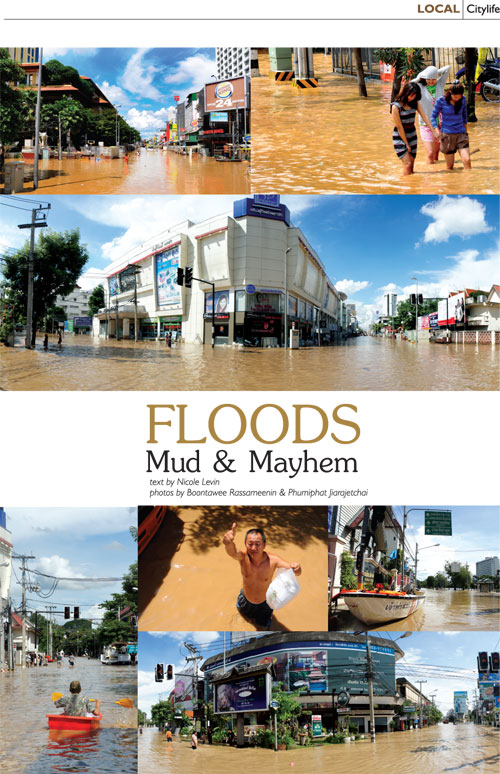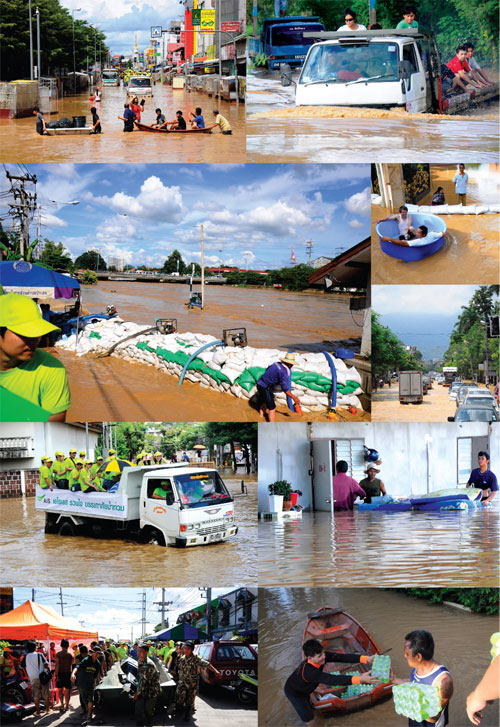

The floods have been dominating local, domestic as well as international media channels since September. They have been described as the worse in over 50 years, and have reached national crisis proportions. Images of the partially submerged UNESCO World Heritage Sites at Ayutthaya and roads that now resemble canals, if not rivers, represent the crescendo of the 2011 monsoon season. By the beginning of October, the flooding had hit a total of 28 provinces and affected more than 2.6 million people. With regards to the death toll, at the time of writing it stood at 340 with three people still missing. The effects on agriculture and the working population have also been vast with 7.5 million rai of farmland ravaged which will undoubtedly affect next year’s rice crop harvest by raising the price of the nation’s staple food. The floods have also disrupted production and international supply chains with as many as 1,215 factories submerged affecting more than 41,000 workers nationwide. By mid-October the focus was on protecting Bangkok as the water headed slowly but surely southwards on its way out to the Gulf of Thailand. The districts in the north of Bangkok were told to brace for flooding as the government and the Bangkok Metropolitan Administration agreed to drain the northern run-off via the city’s canals. Residents were however told not to panic any further and that central Bangkok would not be under any risk as news continued to worry residents, businesses, overseas investors and tourists. The central bank also announced that the damage to industry alone amounted to over 100 billion baht to date.
Chiang Mai witnessed the worse of the monsoonal rains on the 28th of September with the Ping River rising to a phenomenal 4.94m (the critical level stands above 2.5m) at Nararat Bridge, a focal point in downtown Chiang Mai. Unfortunately the many sandbags that had been lining the streets in the days leading up to the worse flooding the town had seen since 2005 failed to hold back the water. As a result commercial zones including San Pa Khoi Road, Warorot Market and the Night Bazaar were severely affected. Although the disruption in the Night Bazaar area only lasted three days, the estimated damages and lost revenues have been put between 1 and 3 billion baht. More than 20,000 people were said to have been affected with many treading in waist high waters in their own homes. Most of the fatalities occurred elsewhere in the province as a result of landslides.
Although Thailand is used to monsoon rains at this time of year, the intensity of the floods of the past couple of months, which were triggered by typhoon Haima and tropical storm Nock-Ten, was completely unexpected.
The widespread devastation and destruction has now affected farmland, infrastructure, a large proportion of the population and the economy. However the question many people are asking is ‘why’ and ‘how’ the flooding could have escalated to such a widespread natural disaster. This is something everyone, from ministers to farmers, is trying to understand and scrambling to find a future prevention against. Global warming, El Niño, and deforestation have all contributed to the floods in some way or another. Deforestation, which is so common in today’s world especially in developing countries, is probably the main driving force behind the severity of the floods. Forests, fields and open green areas are vanishing at an alarming rate in order to accommodate the rapid population growth. With no forests or trees to absorb the water, economic zones and residential areas bear the brunt of the rising waters as the rain has nowhere to go but to fill the streets. And the government’s muddling announcements and confusing leadership has not helped.
In times of hardship a real sense of community spirit can always be seen in Chiang Mai, and indeed Thailand as a whole, and this time it was mirrored in the amount of donations received. Donation boxes along the Sunday Walking Street have up to date raised over 120,000 baht. An additional 170,000 baht was collected from the many donation boxes set up by the municipality around the city, though much more has been sent to larger funds set up in the capital. The Red Cross has also played an active part with their rescue, relief, and recovery efforts in a total of 29 provinces distributing relief goods, providing mobile kitchens, and water purification teams. As of 7th October, 93,482 relief kits and 84,569 packs of drinking water had been distributed to victims.
Future?
A week after the floods in Chiang Mai, the Governor ML Panadda Diskul chaired a meeting where flood prevention measures were discussed. The options put forward include the construction of a 14.88 km long flood protection wall along the Ping River, a water diversion tunnel and forest rehabilitation.
As the flooding continues its journey south, Citylife hopes that residents in Chiang Mai are coping well in the aftermath of the floods and our thoughts go out to the rest of Thailand who are still heavily affected. We are confident that national and international relief efforts will do all they can to ensure a rapid recovery. If you would like to donate please see the details below:
Prime Minister’s Office:
Bank: Krung Thai Bank, Government House sub-branch
Account Name: PM’s Office’s Relief Fund for Flood Victims
Account Number: 067-0-06895-0
The Thai Red Cross Society
Bank: Siam Commercial Bank, Thai Red Cross Society branch
Account Number: 045-3-04190-6
Public Health Ministry
Bank: Siam Commercial Bank
Account Name: Public Health Ministry for Flood Victims
Account Number: 340-2-11600-7
For more information, call 02-590-7104-5, 02-590-7196
Useful contact numbers:
Government call centre 1111 ext 5
Disaster Prevention and Mitigation Department Hotline 1784
Royal Irrigation Department Hotline 1460
For further information:
Red Cross http://english.redcross.or.th/home
For maps: http://www.google.org/crisisresponse/thailand-flood-2011.html
For daily reports: http://www.disaster.go.th/dpm/